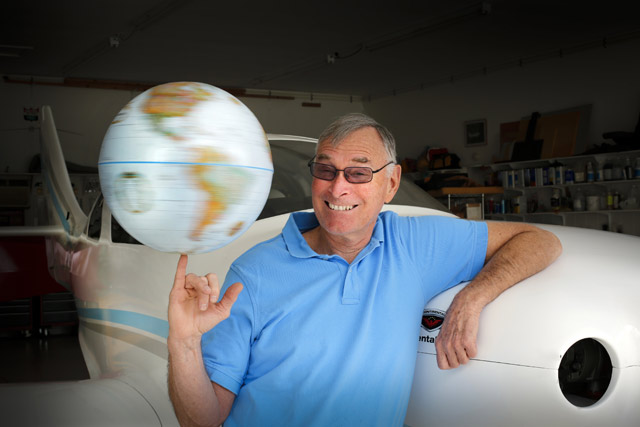
Bill Harrelson’s weight-class world record flight over both the north and south poles almost ended before it began. While pushing the heavily fuel-laden Lancair IV onto a set of scales, the single-engine aircraft tipped backward and its carbon-fiber rudder struck the ground, damaging it.
“I seriously considered ending the record attempt right there,” said Harrelson, 64, who—with his wife Sue—had spent eight years building the specialized aircraft for this audacious, ultra-long-distance flight. “But in the end, I ended up getting some duct tape, and it held on through the entire flight—and some pretty extreme temperatures.”
He also saw the towering and majestic 12,000-foot peaks of the Antarctic Peninsula up close, circled the South Pole (which, he says, resembles “a junkyard at the end of the world”), overflew shimmering South Pacific waters and atolls, watched the sun rise and set minutes apart near the Arctic Circle, and flew for hours at the top of the world in total darkness.
Harrelson, who lives at Dogwood Airpark in Fredericksburg, Virginia, paid about $25,000 for the trip from his own savings—and he sought no corporate backing. “I didn’t want the pressure that [sponsors] would bring,” he said. “If I taxied to the runway and didn’t feel things were right, I wanted to be able to turn around and scrap the record attempt without disappointing anyone.”
Several aviation firms supported Harrelson’s effort, knowing that the high-risk flight would be entirely under the direction of the Harrelsons and their small team of international flying experts, and that it could be cancelled at any time. (Monty Barrett’s Precision Engines customized the Lancair’s Continental IO-550 engine, and Continental Engines and Camguard pitched in, too.)
The December 2014/January 2015 flight was Harrelson’s second attempt at the record. The first trip ended at the tip of South America in 2013 when adverse weather in Antarctica frustrated his efforts. This time, Harrelson elected to go at the height of summer in the Southern Hemisphere for the best chance of favorable weather there, and confront the Arctic in the frigid darkness of winter.
“I learned on my first attempt that Antarctica and the Southern Ocean presented the biggest obstacles,” he said. “The timing of this trip was meant to give me the best chance for favorable weather in that region.”
A beast
The Lancair IV has a reputation for delightful control harmony, but when loaded with 361 gallons (2,166 pounds) of avgas in 10 separate tanks, Harrelson’s is a beast. “It’s divergent in both pitch and roll, and the flight characteristics are ugly, ugly, ugly,” he said. “You can’t even think about engaging the autopilot for the first five hours.”
With a full load of fuel and survival gear, Harrelson’s first takeoff from Kinston, North Carolina, was an exceptionally long roll followed by an incredibly shallow climb. Harrelson and his team had selected Kinston Regional Jetport at Stallings Field for its long 11,500-foot runway, low 93-foot elevation, and few obstructions—features that all turned out to be necessary. Even in the cool, smooth air at dawn, Harrelson and his flying fuel tank had to accelerate to 160 KIAS just to eke out a 100-fpm climb.
Harrelson flew over the Atlantic to South America, then on to Punta Arenas at the southern tip of Chile. The weather conditions for the flight to the South Pole were nearly perfect, with visibility of 200 miles or more, but Harrelson’s plan to continue on to New Zealand was thwarted by powerful headwinds and potential airframe ice in his path. Ice was the most perilous threat because the Lancair has no deice or anti-ice systems, and the thin, laminar flow airfoil that makes it so aerodynamically efficient also leaves it susceptible to being brought down by relatively thin ice accumulations.
“I was petrified by the possibility of airframe ice,” Harrelson said. “It was far and away the biggest threat.”
Harrelson took advantage of the weather conditions for a flight over the South Pole on New Year’s Day. Instead of continuing on to New Zealand, however, he returned to Punta Arenas. That added a major complication to winning the record, however, because he had declared Hamilton, New Zealand, as a stopping point on his route and he still needed to get there. Harrelson’s team got busy planning another route with a stop in Tahiti. But there was a three-day delay in getting a landing permit there.
When he finally left Punta Arenas, Harrelson confronted some of the most difficult conditions of the entire trip: turbulence, airframe ice, and a 50-knot headwind. Those conditions eventually relented, and he made it to New Zealand—albeit far behind schedule. The delays were more than annoyances. Harrelson had planned his Arctic crossing to coincide with a full moon, and the lost days would mean crossing the top of the world in total darkness—when the chance of finding an emergency landing site with no light would be virtually nil.
Old and new
Harrelson’s panel is a mix of old and new technologies. On the new side, he’s got a GRT Avionics glass panel and engine monitor, and a Garmin GNS 480 GPS/com navigator. He uses an iPad with the FlyQ app; has Sirius XM Weather (although it only works in the United States); and used an Iridium GO satellite phone extensively, mostly for text messaging.
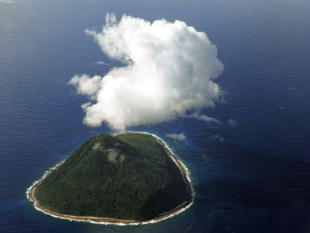
The South Pacific island of Tafahi was the only spot of land Harrelson saw between New Zealand and Hawaii.
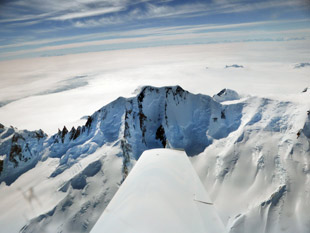
The peaks of Alexander Island on the Antarctic Peninsula rise from the frozen sea to almost 10,000 feet.
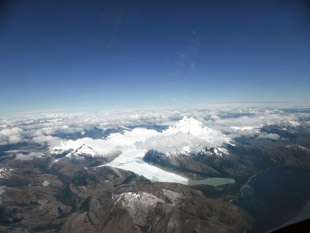
Monte Sarmiento at the southern tip of Tierra del Fuego is 7,175 feet tall and has four glaciers on its slopes.
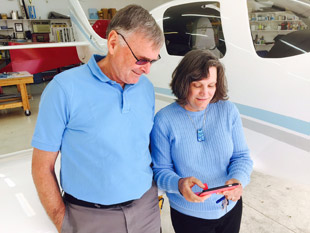
Harrelson his wife, Sue, also a retired airline pilot, receive notice of his new world record.
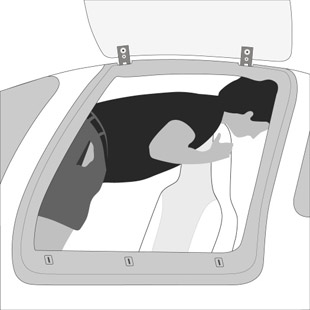
To avoid maladies such as deep vein thrombosis during long endurance flights, Harrelson moved and stretched in his confined seating area. Turning around in his seat while the airplane flew allowed him to stretch the backs of his legs.

Harrelson used Velcro to keep frequently used items within reach. A calculator, spare GPS, pens, lip balm, and skin lotion were stuck to the outside of a fuel tank thatoccupied the right seat position in his aircraft.
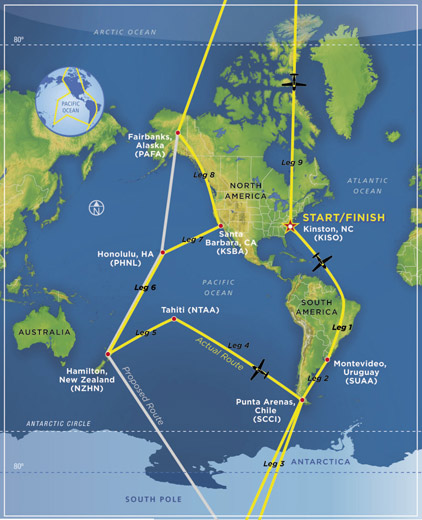
On the old side, he’s also got an analog attitude indicator and directional gyro, ADF, HF radio, and a manual E6B circular flight computer.
“I actually used the E6B quite a lot,” he said. “I’ve got five separate GPSs in the airplane. But ATC sometimes asked me to provide estimated times for boundary crossings into or out of terminal airspace. In those cases, I found it easier and quicker to measure the distance on a chart and use the E6B to come up with the estimate rather than build new GPS waypoints.”
GPS worked well, but there were some complications near the poles as the software that predicts turns got confused. When that happened, Harrelson used the attitude indicator and directional gyro to maintain a steady course.
The Iridium GO messaging system was particularly handy for weather updates. Harrelson’s support team had access to global satellite images and international weather forecasts that helped him avoid violent storms over the South Pacific. “The text messages were indispensable,” he said. “The voice capabilities were always available, but we found text to be so much more efficient that we almost never used voice.”
Harrelson considered bringing music for the flight but didn’t—and he didn’t miss it.
“People assume I must have been bored during some of those long legs, but the truth is that I was busy planning; making position reports; communicating with my team; eating, drinking, or exercising almost all the time,” he said. “There was very little idle time. I’d make a position report every hour, send detailed aircraft and engine performance data, and I forced myself to drink something every hour whether I wanted to or not. It’s easy to get dehydrated.”
For exercise, Harrelson would put the airplane on autopilot, unstrap his seatbelt harness, and turn around. Facing aft allowed him to fully extend his legs, move his arms, bend his back, and avoid the potentially fatal hazard of deep vein thrombosis.
Each hourly status report contained 18 parameters: OAT, altitude, true airspeed, groundspeed, miles per gallon, manifold pressure, rpm, fuel flow, oil pressure and temperature, cylinder head temperature, fuel used, fuel remaining, hourly burn, angle of attack, blood oxygen saturation level, heart rate, and cockpit temperature.
Optimal altitudes varied according to aircraft weight, air temperature, prevailing wind, and other factors. Generally, the Lancair IV does best in the mid-teens, where it travels about 190 KTAS on roughly 12 gph. The IO-550 engine has been modified with heavy 10:1 pistons, as well as GAMI matched fuel injection nozzles for smooth lean-of-peak operations. “Other pilots get high-compression pistons for a higher top speed or a faster climb,” Harrelson said. “I got them for better efficiency in cruise.”
Another detour
Harrelson flew nonstop from New Zealand to Hawaii, and he planned to continue north to Alaska. But the threat of icing over the north Pacific convinced him to change his route. He flew to California, then northwest to Fairbanks, Alaska, for his shot at the North Pole and beyond. Arctic air temperatures were unusually warm when he arrived—but for Harrelson, that was bad news.
“When you get colder than minus 20 degrees C, there’s almost no chance of picking up airframe ice,” he said. “I was glad when I’d see lower temperatures.”
Harrelson dressed in multiple layers for the North Pole flight and directed hot air into his jacket through a flexible tube. But as the outside air temperature dropped to minus 38 degrees C over northern Canada, he was alarmed to see the engine oil temperature fall to just 70 degrees F—about one third its normal value.
“I was never physically uncomfortable,” he said, even though cockpit temperatures remained in the single digits for hours. “The cold temperatures were harder on the engine than me.”
Reentering the United States, Harrelson climbed to 18,000 feet on the final leg of the journey to stay above clouds, and he had to overcome a final hurdle. There was heavy snow, low visibility, and wind in western Pennsylvania, Maryland, and parts of Virginia.
Harrelson was able to avoid the worst of it with the now-functioning XM satellite weather, and he made a normal approach and landing at Kinston, where family and friends were waiting. The previous record for an airplane in the 3,000-kilogram category had been set in 1987 by Richard D. Norton, who took four months to fly a Piper PA-46 Malibu over the poles. Harrelson did it in less than one month.
Harrelson had previously set a world weight-class distance record in his Lancair for a nonstop flight from Guam to Jacksonville, Florida. But he said this polar flight will be his last aviation record.
“I wanted to see if it was possible for a regular person to set a meaningful world aviation record without major corporate backing, or deep pockets of his own,” he said. “It turns out it can be done.”
Email [email protected]
View the video: Watch an interview with Bill Harrelson.



